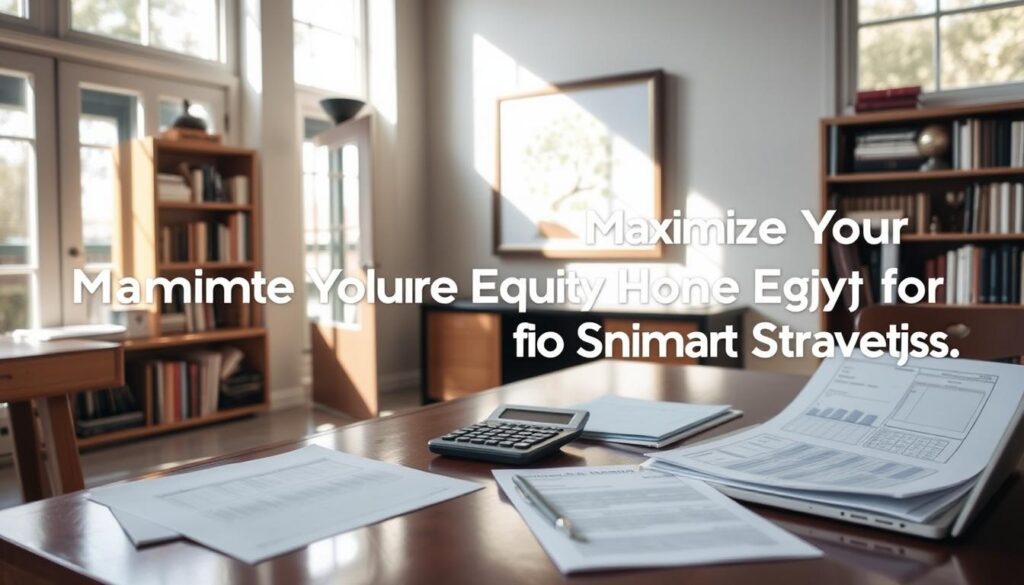Did you know that nearly 40% of U.S. homeowners have over $100,000 in untapped home equity? That’s a staggering figure, showing just how much potential wealth sits in your property. This guide reveals how to turn that hidden value into real opportunities for growth.
Home equity isn’t just a number on a mortgage statement—it’s your gateway to wealth building. As you pay down your loan, your stake in the property grows, turning your home into a powerful financial tool. Whether you’re planning for retirement, funding renovations, or diversifying your assets, this guide breaks down actionable steps to leverage your home’s value.
Discover how smart decisions today can transform your home into a long-term wealth-building machine. Let’s start unlocking its full potential.
Understanding Home Equity
Your home’s equity is the foundation of long-term financial growth. Let’s break down how it works and why it matters today.
Defining Home Equity
Home equity equals your property value minus the remaining mortgage balance. For example, if your home appraises at $300,000 and you owe $150,000, you own $150,000 in equity. This number grows as you pay off loans or market prices rise. According to NerdWallet, equity acts as a silent savings account tied to your home’s worth.
Why It Matters for Your Finances
Equity transforms your home into a flexible asset. Here’s how it helps:
- Builds wealth without relying solely on stock markets or other investment strategies
- Offers access to cash through loans or lines of credit
- Protects your net worth as housing markets fluctuate
Every dollar added to equity strengthens your financial safety net.
The Current Home Equity Landscape
Today’s market shows homeowners gain equity through time and market trends. Key factors include:
- The “five-year rule”: Most sellers need 5+ years to break even on closing costs
- Rising property values in regions like the Southeast and urban hubs
- Options like HELOCs or cash-out refinances let you tap equity strategically
Maintaining good credit and consistent payments maximizes equity potential. Tracking your home’s property value annually ensures you’re positioned to leverage it in investment strategies or emergencies.
Exploring the Basics of Home Equity Investment
Home equity investment lets you turn your home’s value into cash without selling. This option uses your home’s equity as collateral, offering flexibility for projects like renovations or debt consolidation. Let’s break down the essentials:
| Requirement | Details |
|---|---|
| Minimum Credit Score | 500 |
| Required Equity | 30% of home value |
| Home Value Threshold | $250,000 |
| Origination Fees | 3.9% to 5% |
| Term Length | 30 years |
These guidelines ensure you qualify. Benefits include no monthly payments and repayment at the end of the term or when you sell. But there’s a catch: you share future home value gains with the investor.
- Flexible funding for home projects or financial goals
- No monthly payments during the 30-year term
- Access up to 30% equity of your home’s worth
Repayment happens in one lump sum or at sale time. Keep in mind, a portion of your home’s future value goes to the investor. Learn more about how equity investments work to decide if this aligns with your financial plan.
Step-by-Step Guide to Home Equity Investment
Turning home equity into wealth starts with clear steps. Follow this guide to transform your property into a financial opportunity without guesswork.
Assessing Your Home’s Current Worth
Begin by pinpointing your home’s market value. Professional appraisals and online comparables (comps) from platforms like Zillow or Realtor.com reveal its true potential. Track recent sales of similar homes in your area to spot trends. Bankrate’s latest reports highlight how updated data ensures accurate starting points for investment decisions.
Preparing for Investment
Secure equity financing options early. Compare home equity loans, HELOCs, or cash-out refinance rates using tools from lenders like Chase or Wells Fargo. Set a budget aligned with your long-term goals. Financial advisors recommend reserving 10-15% of your budget for unexpected costs. Review local building codes to avoid legal pitfalls before starting projects.
Implementing a Strategic Plan
Focus on projects boosting renovations ROI. Kitchens and bathrooms typically add 80-100% value, per Remodeling magazine. Prioritize high-demand upgrades like energy-efficient windows or smart home tech. Monitor progress by tracking monthly equity gains and recalibrate spending based on market shifts. Reinvest profits into low-risk areas to amplify wealth over time.
- Secure financing options from reputable lenders.
- Use renovation checklists to prioritize high-value projects.
- Track ROI quarterly using appraisal updates.
Every step builds toward turning your home into a dynamic asset. Start small, stay informed, and watch equity grow steadily.
Building Wealth with Home Equity Investment
Unlocking the full potential of your home’s value starts with smart strategies tailored to grow your equity. Whether you’re planning to sell or reinvest, these steps turn your home into a financial engine.
Identifying Profitable Opportunities
Look for high-return upgrades like modernizing kitchens or adding outdoor spaces. Check Redfin or Zillow to compare local sales and spot trends. Focus on projects that boost curb appeal—updated bathrooms or energy-efficient windows often pay off at resale.
Strategies to Optimize Returns
Reinvest equity gains into income-generating assets like rental properties or stocks. Use a NerdWallet loan calculator to compare HELOC rates, ensuring low-cost financing for upgrades. Prioritize quality contractors and permits to avoid costly mistakes.
- Track home value trends via county assessor websites
- Consult real estate agents for neighborhood-specific advice
- Use equity to pay off high-interest debt first
Every dollar reinvested wisely grows your equity faster. Start small with cosmetic fixes before tackling major renovations to see market reactions.
Key Strategies to Maximize Your Home Equity
Boosting your home equity doesn’t require drastic changes. Start with small, strategic steps proven to grow your property’s worth. Here’s how to act:
- Maintain Routine Upkeep. Fix leaks, repaint peeling walls, and check roofs yearly. Neglecting minor issues can cost thousands later. A well-maintained home stays attractive to buyers and lenders.
- Invest in High-Impact Renovations. Kitchens and bathrooms deliver top returns. Installing quartz countertops or modern showers adds visible value. Case studies show these upgrades boost home equity by 5-10%.
- Follow Market Trends. Track local demand. Solar panels, smart home tech, or open floor plans may surge in value depending on your area. Research neighbors’ sales to spot trends.
Focus on energy efficiency too. ENERGY STAR-rated windows or insulation lowers bills and appeals to eco-conscious buyers. Pro tip: Prioritize projects that align with your budget and neighborhood standards. Avoid over-customizing—stick to upgrades most buyers value. Every smart choice today strengthens your home’s resale or refinancing potential tomorrow.
Evaluating Your Home’s Value
Knowing your home’s worth is key to smart mortgage management and long-term financial planning. Start by understanding how professionals assess value and track market shifts that affect your investment.

Appraisal Methods
Three core approaches shape home valuations:
- Comparative Market Analysis (CMA): Compares recent sales of similar homes in your area.
- Income Approach: Estimates value based on rental income potential.
- Cost Approach: Calculates rebuilding costs minus land value.
Market Trends and Analysis
Track these factors to align mortgage management with market realities:
- Local Sales Data: Use platforms like Zillow or Realtor.com to compare recent transactions.
- Economic Indicators: Monitor interest rates and job growth in your region.
- Home Condition: Updates like a new roof or kitchen can boost equity, per 2023 data from the National Association of Realtors.
Regular appraisals and trend analysis help adjust your strategy. For instance, a 2022 CoreLogic report shows homes in strong school districts gain 12% more value annually. Use this insight to refine your mortgage management plan and seize opportunities as they arise.
Financing Options for Home Equity Investment
Picking the right financing choice makes all the difference when using your home equity. Explore these options to align your investment goals with your financial comfort zone.
Understanding Home Equity Loans
A home equity loan gives you a one-time cash lump sum based on your home’s value. These loans come with fixed interest rates and fixed repayment terms. For example, a $50,000 loan at 6% APR would have steady monthly payments over 10–15 years. Lenders like Chase or Bank of America often require 15–20% equity to qualify.
- Fixed-rate payments for predictable budgets
- Perfect for one-time expenses like home upgrades
- Credit score requirements typically 620+ for approval
Considering Lines of Credit
A home equity line of credit (HELOC) works like a credit card secured by your home. You can borrow up to your approved limit over a draw period, say 10 years, with variable rates tied to the prime rate. Wells Fargo and US Bank offer HELOCs with terms up to 30 years total. Payments adjust monthly based on market changes.
- Flexible access to funds as needed
- Variable rates that may rise or fall
- Suitable for ongoing projects like kitchen remodels
Alternative Financing Methods
If traditional loans don’t fit, explore alternatives like peer-to peer platforms (e.g., Upstart) or 0% APR credit cards. These options avoid using your home as collateral but may carry higher interest rates. Always compare terms using online loan calculators to see which aligns with your cash flow.
- Personal loans with shorter terms (1–7 years)
- Crowdfunding sites for home improvement campaigns
- Reverse mortgages for seniors over 62 (not advised for younger borrowers)
Risk Management in Home Equity Investment
Managing risks is key to protecting your home equity investments. Market shifts or unexpected costs can impact your financial goals. Risk management helps you stay steady and avoid pitfalls like over-borrowing or sudden price drops.
- Market Volatility: Property values can rise and fall with economic trends.
- Over-Leveraging: Borrowing too much may strain your budget.
- Unexpected Expenses: Repairs or interest rate hikes can add costs.
| Risk | Strategy |
|---|---|
| Market Downturns | Track trends monthly; consult a financial advisor. |
| High Debt Levels | Keep loans under 80% of your home’s value. |
| Emergencies | Set aside 3-6 months of expenses as a cash reserve. |
Always review loan terms and maintain a budget. Tools like risk management plans help you stay in control. Experts advise reviewing your strategy yearly to adapt to changes. Protecting your equity starts with knowing the risks—and how to handle them.
Leveraging Home Equity for Long-Term Financial Gains
To turn your home into a long-term wealth-building tool, start by viewing it as part of a larger financial strategy. A home appraisal provides the data needed to understand how much equity you have to work with. Experts advise using this value as a foundation for broader investment plans.
Creating a Diversified Portfolio
Combine home equity with other assets like stocks, bonds, or rental properties. Regular home appraisals ensure you know your equity position before making moves. For example:
- Use 10-15% of equity for risk-free opportunities
- Reinvest gains into property improvements to boost resale value
Balancing Short-Term and Long-Term Goals
Consider this comparison when planning:
| Goal Type | Strategies |
|---|---|
| Short-term | Emergency funds, home repairs |
| Long-term | Roth IRAs, retirement accounts |
Always align decisions with updated home appraisal results. This ensures every financial step strengthens both immediate needs and future stability. Smart planning transforms your home into a dynamic asset that grows with your life goals.
Tax Implications and Legal Considerations
Navigating tax rules and legal requirements is key when investing in home equity. Here’s what you need to know to stay compliant and maximize savings.
Start by understanding tax deductions available to you. Common opportunities include:
- Mortgage interest deductions for primary/secondary homes (up to $750,000 in loan limits)
- State and local property taxes (subject to annual caps)
- Possible capital gains exclusion ($250,000 for singles, $500,000 for married couples when selling)
| Deduction Type | Eligibility | Max Limit |
|---|---|---|
| Mortgage Interest | Primary/Secondary Homes | $750,000 loan limit |
| Property Taxes | Paid to local government | Varies by state |
| Sale Exclusion | Ownership/occupancy 2 of last 5 years | $250K single / $500K married |
- Review local zoning laws for renovations
- Check loan terms for tax deductibility of interest
- Consult a tax pro annually to adjust strategies
IRS guidelines and state laws vary, so stay informed. Small missteps could cost you thousands. Use this info to protect your investments and stay compliant.
Actionable Tips for Home Equity Improvement
Boosting your home’s equity doesn’t require a total renovation. Small, smart choices today can make a big difference. Follow these strategies to grow your investment without overspending.
Simple Upgrades That Add Value
- Upgrade lighting fixtures and hardware for a modern look.
- Install energy-efficient windows to cut utility bills and attract buyers.
- Add curb appeal with fresh paint and well-kept landscaping.
Effective Maintenance Strategies
Regular upkeep keeps your home in top condition:
Inspect roofs, gutters, and plumbing yearlyto prevent costly repairs. Trim trees, clear drains, and seal cracks promptly. A clean, well-maintained home stays competitive in the market.
Budgeting for Home Improvements
Stick to your budget with these steps:
- Set a clear budget before starting any project.
- Shop at retailers like Home Depot or Lowe’s for cost-effective materials.
- Consider financing options like home equity loans if needed.
Focus on projects that offer the best return. Prioritize upgrades buyers care about, like kitchens or bathrooms. Every dollar spent wisely strengthens your equity over time.
Conclusion
Building wealth through home equity starts with understanding its value and strategic planning. By assessing your home’s worth, choosing the right financing options, and prioritizing smart upgrades, you position yourself to grow your financial future. Every step from market analysis to maintenance plays a role in turning your home into a powerful asset.
Data shows that proactive management of equity through investments like energy-efficient upgrades or kitchen remodels can boost resale value significantly. Tools like home equity loans or lines of credit offer flexible ways to access funds while balancing risks. Remember, long-term success comes from aligning these strategies with your financial goals.
Take the first step today: schedule a professional appraisal, review your budget, or explore financing options with lenders like Quicken Loans or Chase. Small, informed choices now can lead to major gains over time. Your home isn’t just where you live—it’s a cornerstone of your financial journey. Make every decision count.



